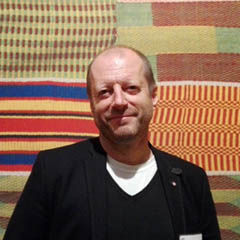Owusu-Ankomah received his basic training at Ghanatta College of Art in Accra. He was thirty years old when he moved to Bremen in Germany, where he still lives and works today. Characteristic of Owusu-Ankomah is his devotion to painting. For him the act of painting is a kind of highly concentrated ritual in which the medial properties of his body are used as memory store and energy-field generator, rather in the manner of an action artist.
In the course of his life, Owusu-Ankomah's artistic work has passed through several distinct phases. From an iconographic point of view, his early work is strongly influenced by mask and rock painting traditions from all over the African continent. But it was not long before human bodies, especially his own, became the dominant subject of his work. Naked bodies in his paintings, represented in idealized and naturalistic perfection, demonstrate a shameless and very close physicalness and often seem to radiate superhuman energy. Owusu-Ankomah plays here with the beauty of the human male body and with the harmony of flowing, clear lines. These works also evoke a range of ideas inspired by the human body – the body as instrument of the soul and instrument of communication, as a universal symbol and point of intersection between the physical and the metaphysical, and as a means by which the individual constructs himself, presents himself to others, and negotiates the conditions of his belonging to the world.
In his recent works up to 2008, the figures are covered with markings and signs. They originate from a variety of sources: the artist has combined traditional West African symbols, such as adinkra cloth signs, with symbols from China, America and Oceania, well-known popular logos, and symbols of his own invention. The figures melt into the backgound which consists of the same symbols, and thus become almost invisible.
With these symbols and human figures that compete for space on the canvas and for the attention of the viewer, Owusu-Ankomah has created some highly dynamic and truly pulsating compositions. The works also raise questions concerning self-determination and heteronomy, the tension between the wisdom of collective worldviews and individual creativity, and the personal potential of the individual. This is particularly striking in works showing the Sankofa bird. This mythical bird is well known in large parts of West Africa and embodies the concept of "flying forward while looking back". It symbolizes the idea that one should remember the past in order to shape one's life positively in the present and the future. With its name meaning "go back and pick", the bird also stands for one of Owusu-Ankomah's guiding principles: to look for useful traditions in all parts of the world. Accordingly, Owusu-Ankomah borrows a great variety of elements from very different cultures and periods in his works. He is influenced by adinkra symbols, together with their worldviews and philosophies, but also by Michelangelo, video games and designs by popular contemporary graphic artists. In his ambition to unite elements from very different regions in one great human universal, his works become something that overcomes the borders separating individual cultures. In his search for an existential utopia, he creates a symbiosis out of these heterogeneous elements in fantastic and futuristic spaces. Thus he aims at a common "world consciousness" and global visions of the establishment of universally longed-for values, such as harmony, solidarity and non-violence.
An interpretation of an early work by the artist from 1975, "Deer Hunt", can be found under the following link.

